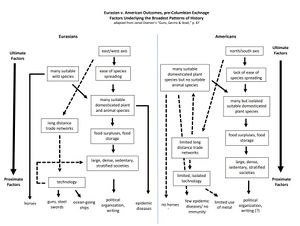Columbian Exchange
- the exchange, or transfer, or plants, animals and disease to and from the Americas and the rest of the world following the discovery of the Americans by Christopher Columbus in 1492.
>> to do: create tables?
Background[edit | edit source]
Columbus

Spanish conquest[edit | edit source]
- a core question about the Columbian exchange is why did the Spanish conquer the Americas in the Americas and one of the Native American empires did not invade and conquer Spain?
- Jared Diamond's "Guns, Germs and Steel" explores this question
- Diamond's analysis shows that the "broad" or very long-term causality of the outcome that that Spanish conquered the Americas and not the other way around is due to geography, notably:
- continental axis:
- east-west axis of Eurasia allowed for exchange
- north-south axis of the Americas limited exchange
- domesticable plants
- both regions had an abundance of domesticable plants
- but Eurasia had more available plants
- and given the east-west axis of Eurasia, those plants were spread
- therefore, Eurasian populations arose earlier than those in the Americas
- and centralized societies that might want to attack one or the other arose earlier in Eurasia
- domesticable animals
- the Americas lacked animals that are appropriate for food consumption and transport
- especially the horse
- many contageous diseases originated from human proximity to domesticated animals
- lacking those animals, the Americans had no immunity to Eurasian diseases
- the Americas lacked animals that are appropriate for food consumption and transport
- these combinations yielded advantages to Eurasian societies that the Spanish used in their conquest of the Americas, including
- technologies of guns and steel (used for weapons and tools)
- horses (war horses provided a considerable military advantage)
- disease, which killed off a tremendous number of Native Americans and weakened their centralized states
- continental axis:
Plants[edit | edit source]
- the most important exchange was
- deepest impacts include:
animals from the Americas[edit | edit source]
- turkeys
plants from the Americas[edit | edit source]
- beans
- chocolate
- maize (corn)
- potatoes
- sweet potatoes
- tomatoes
diseases from the Americas[edit | edit source]
- syphilis
animals to the Americas[edit | edit source]
- chickens
- cows
- horses
- pigs
diseases to the Americas[edit | edit source]
- malaria (from Africa)
- small pox
plants to the Americas[edit | edit source]
- apples
- coffee (from Africa)
- wheat
Animals[edit | edit source]
- the most important exchange was:
- introduction of farm animals to the Americas
- deepest impacts include:
from the Americas[edit | edit source]
to the Americas[edit | edit source]
Insects[edit | edit source]
- the most important exchange was:
- deepest impacts include:
- European honey bees
- English earth worms
- the ice sheet and tundra climat killed the earthworms across northern North America
- introduction of English worms re-worked the soil and changed the ecosystem
from the Americas[edit | edit source]
to the Americas[edit | edit source]
Disease[edit | edit source]
- the most important exchange was:
- deepest impacts include:
from the Americas[edit | edit source]
to the Americas[edit | edit source]
Technologies[edit | edit source]
- the most important exchanges were:
- iron
- gunpowder
- horses
- deepest impacts include:
- increase in deadliness of Native American tribal warfare
- mass killing of North American buffalo herds via horse and firearms use
- North American Native American armed resistance to European encroachment
from the Americas[edit | edit source]
- rubber
- rubber is a natural latex
- it is a milky-substance, like sap, that is derived from certain tropical trees
- various latex-producing, rubber trees exist around the world
- however, the Brazilian "Rubber Tree" is the primary source of industrial-use rubber
- the Rubber Tree is a native plant of the Amazon (can grow to 140 feet)
- earliest documented use of natural latex (rubber) was by the Olmec civilization in Mesoamerica (central America)
- the Olmec and, later, Maya and Aztec, used rubber for balls for sports
- the Aztec added rubber to cloth to make it waterproof
- see
- Heva Brasiliensis (wiki) for the story of this important plant
- https://www.oringsusa.com/Rubber_Intro.pdf Brief History of Rubber (originsusa.com)]
- rubber is a natural latex
- canoes
- from the Tiaino word <<
- farming techniques
to the Americas[edit | edit source]
- horses
- iron
- alcohol
Language[edit | edit source]
- the most important exchange was:
- deepest impacts include:
from the Americas[edit | edit source]
to the Americas[edit | edit source]
Other cultural, political and religious exchange[edit | edit source]
- the most important exchange was:
- deepest impacts include: